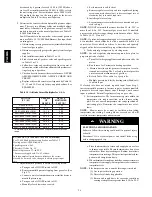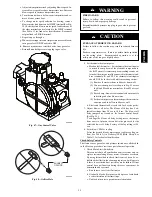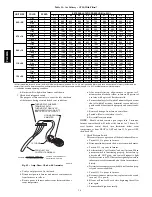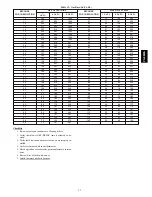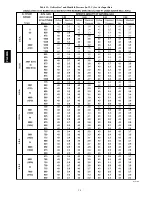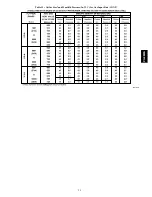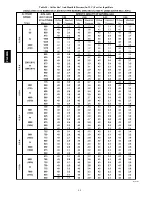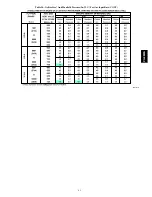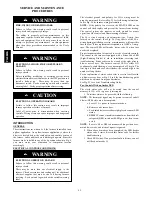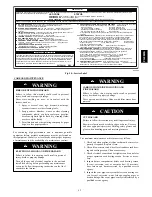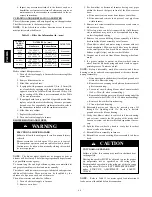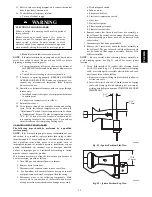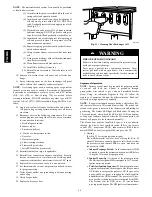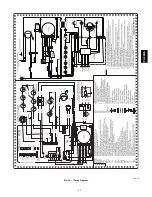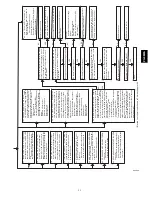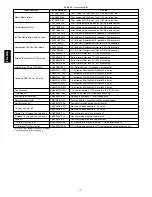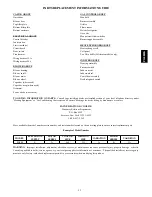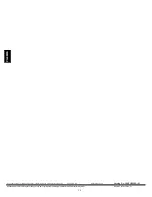
47
gized until the flame is sensed or until the 2--second flame
proving period begins.
d.
Flame--Proving
-- When the burner flame is proved at the
flame--proving sensor electrode FSE, the furnace control
CPU begins the blower--ON delay period and continues
to hold the gas valve GV open. If the burner flame is not
proved within two seconds, the control CPU will close
the gas valve GV, and the control CPU will repeat the ig-
nition sequence for up to three more Trials--For--Ignition
before going to Ignition--Lockout.
Lockout will be reset
automatically after three hours or by momentarily inter-
rupting 115 vac power to the furnace, or by interrupting
24 vac power at SEC1 or SEC2 to the furnace control
CPU (not at W, G, R, etc.).
If flame is proved when flame should not be present, the
furnace control CPU will lock out of Gas--Heating mode
and operate the inducer motor IDM until flame is no
longer proved.
e.
Blower--On Delay
-- If the burner flame is proven, the
blower motor is energized on HEAT speed 25 seconds
after the gas valve GV is energized.
Simultaneously, the electronic air cleaner terminal
EAC--1 is energized and remains energized as long as the
blower motor BLWM is energized.
f.
Blower--Off Delay
-- When the thermostat is satisfied, the
R--to--W circuit is opened, de--energizing the gas valve
GV, stopping gas flow to the burners, and de--energizing
the humidifier terminal HUM. The inducer motor IDM
will remain energized for a 5--second post--purge period.
The blower motor BLWM and air cleaner terminal
EAC--1 will remain energized for 90, 120, 150, or 180
seconds (depending on the blower--OFF delay selection).
The furnace control CPU is factory--set for a 120--second
blower--OFF delay.
2.
Cooling Mode
The thermostat “calls for cooling.”
a. Single--Speed Cooling
(See Fig. 25 -- 32 for thermostat connections)
The thermostat closes the R--to--G--and--Y circuits. The
R--to-- Y circuit starts the outdoor unit, and the R--to--
G--and--Y/Y2 circuits start the furnace blower motor
BLWM on COOL speed.
The electronic air cleaner terminal EAC--1 is energized
with 115 vac when the blower motor BLWM is operating.
When the thermostat is satisfied, the R--to--G--and--Y cir-
cuits are opened. The outdoor unit will stop, and the fur-
nace blower motor BLWM will continue operating on the
COOL speed for an additional 90 seconds. Jumper Y/Y2
to DHUM to reduce the cooling off--delay to 5 seconds.
(See Fig. 24.)
b.
Two--Speed Cooling
(See Fig. 25 -- 32 for thermostat connections.)
The thermostat closes the R--to--G--and--Y1 circuits for
low--cooling or closes the R--to--G--and--Y1--and--Y2 cir-
cuits for high--cooling. The R--to--Y1 circuit starts the
outdoor unit on low--cooling speed, and the R--to--
G--and--Y1 circuit starts the furnace blower motor
BLWM on low--cool speed (same speed as FAN). The
R--to--Y1--and--Y2 circuits start the outdoor unit on high--
cooling speed, and the R--to--G and-- Y/Y2 circuits start
the furnace blower motor BLWM on COOL speed.
The electronic air cleaner terminal EAC--1 is energized
with 115 vac whenever the blower motor BLWM is oper-
ating.
When the thermostat is satisfied, the R--to--G--and--Y1 or
R--to--G--and--Y1 and Y2 circuits are opened. The out-
door unit stops, and the furnace blower BLWM and elec-
tronic air cleaner terminal EAC--1 will remain energized
for an additional 90 seconds. Jumper Y1 to DHUM to re-
duce the cooling off--delay to 5 seconds. (See Fig. 24.)
3.
Humidity Sensing Thermostat Mode
(See Fig. 26 -- 29 for humidity sensing thermostat connec-
tions.)
The dehumidification output, DHUM on the humidity
sensing thermostat should be connected to the furnace
control thermostat terminal DHUM. When there is a dehu-
midify demand, the DHUM input is activated, which
means 24 vac signal is removed from the DHUM input
terminal. In other words, the DHUM input logic is re-
versed. The DHUM input is turned ON when no dehumid-
ify demand exists. Once 24 vac is detected by the furnace
control on the DHUM input, the furnace control operates
in humidity sensing thermostat mode. If the DHUM input
is low for more than 48 hours, the furnace control reverts
back to non--humidity sensing thermostat mode.
The cooling operation described in item 2. above also ap-
plies to operation with a humidity sensing thermostat. The
exceptions are listed below:
a. When the R--to--G--and--Y1 circuit is closed and there is
a demand for dehumidification, the furnace blower motor
BLWM will continue running at low--cool speed (same
speed as FAN).
b. When the R--to--G--and--Y/Y2 circuit is closed and there
is a demand for dehumidification, the furnace blower mo-
tor BLWM will drop the blower speed from COOL to
HEAT for a maximum of 10 minutes before reverting
back to COOL speed. If there is still a demand for dehu-
midification after 20 minutes, the furnace control CPU
will drop the blower speed back to HEAT speed. This al-
ternating 10-- minute cycle will continue as long as there
is a call for cooling.
c. When the “call for cooling” is satisfied and there is a de-
mand for dehumidification, the cooling blower--off delay
is decreased from 90 seconds to 5 seconds.
4.
Continuous Blower Mode
When the R--to--G circuit is closed by the thermostat, the
blower motor BLWM will operate on continuous--blower
speed (can be adjusted to FAN, HEAT, or COOL speed) at
the thermostat. Factory default is FAN speed. Terminal
EAC--1 is energized as long as the blower motor BLWM is
energized. During a call for heat, the blower BLWM will
stop during igniter warm--up (17 seconds), ignition (7
seconds), and blower--ON delay (25 seconds), allowing
the furnace heat exchangers to heat up more quickly, then
restarts at the end of the blower--ON delay period at HEAT
speed.
In heating, the furnace control CPU will hold the blower
motor BLWM at HEAT speed during the selected blower--
OFF delay period before reverting to continuous--blower
speed. When the thermostat “calls for low--cooling,” the
blower motor BLWM will switch to operate at low--cool
speed (same speed as FAN). When the thermostat is satis-
fied, the blower motor BLWM will operate an additional
90 seconds on low--cool speed (same speed as FAN) be-
fore reverting back to continuous--blower speed.
When the thermostat “calls for high--cooling”, the blower
motor BLWM will operate at COOL speed. When the
thermostat is satisfied, the blower motor BLWM will oper-
ate an additional 90 seconds on COOL speed before re-
verting back to continuous--blower speed.
When the R--to--G circuit is opened, the blower motor
BLWM will continue operating for an additional 5
seconds, if no other function requires blower motor
BLWM operation.
Continuous Blower Speed Selection from Thermostat
--To select different continuous--blower speeds from the
PG
8M
EA
Содержание PG8JEA
Страница 4: ...4 A10269 Fig 2 Clearances to Combustibles PG8MEA ...
Страница 28: ...28 A10133 Fig 33 Chimney Inspection Chart PG8MEA ...
Страница 38: ...38 Table 13 Orifice Size and Manifold Pressure In W C for Gas Input Rate A10180 PG8MEA ...
Страница 39: ...39 Table 13 Orifice Size and Manifold Pressure In W C for Gas Input Rate CONT A10180A PG8MEA ...
Страница 40: ...40 Table 14 Orifice Size And Manifold Pressure In W C For Gas Input Rate A10181 PG8MEA ...
Страница 41: ...41 Table 14 Orifice Size And Manifold Pressure In W C For Gas Input Rate CONT A10181A PG8MEA ...
Страница 49: ...49 A08176 Fig 54 Wiring Diagram PG8MEA ...


